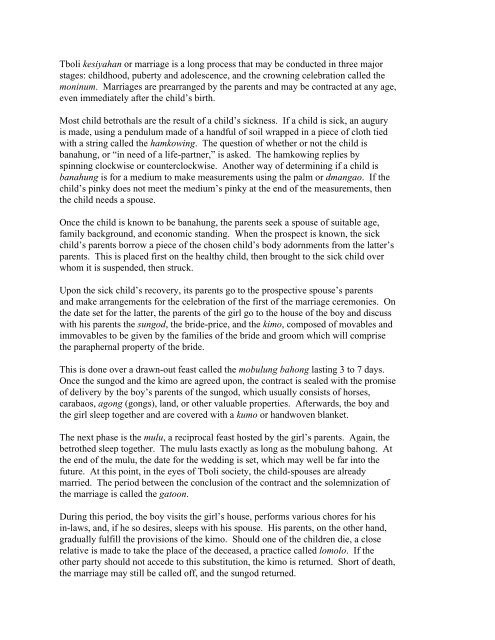The Tboli, also known as T'boli, Tiboli, and Tagabili, are an old ...
The Tboli, also known as T'boli, Tiboli, and Tagabili, are an old ...
The Tboli, also known as T'boli, Tiboli, and Tagabili, are an old ...
You also want an ePaper? Increase the reach of your titles
YUMPU automatically turns print PDFs into web optimized ePapers that Google loves.
<strong>Tboli</strong> kesiyah<strong>an</strong> or marriage is a long process that may be conducted in three major<br />
stages: childhood, puberty <strong><strong>an</strong>d</strong> adolescence, <strong><strong>an</strong>d</strong> the crowning celebration called the<br />
moninum. Marriages <strong>are</strong> prearr<strong>an</strong>ged by the p<strong>are</strong>nts <strong><strong>an</strong>d</strong> may be contracted at <strong>an</strong>y age,<br />
even immediately after the child’s birth.<br />
Most child betrothals <strong>are</strong> the result of a child’s sickness. If a child is sick, <strong>an</strong> augury<br />
is made, using a pendulum made of a h<strong><strong>an</strong>d</strong>ful of soil wrapped in a piece of cloth tied<br />
with a string called the hamkowing. <strong>The</strong> question of whether or not the child is<br />
b<strong>an</strong>ahung, or “in need of a life-partner,” is <strong>as</strong>ked. <strong>The</strong> hamkowing replies by<br />
spinning clockwise or counterclockwise. Another way of determining if a child is<br />
b<strong>an</strong>ahung is for a medium to make me<strong>as</strong>urements using the palm or dm<strong>an</strong>gao. If the<br />
child’s pinky does not meet the medium’s pinky at the end of the me<strong>as</strong>urements, then<br />
the child needs a spouse.<br />
Once the child is <strong>known</strong> to be b<strong>an</strong>ahung, the p<strong>are</strong>nts seek a spouse of suitable age,<br />
family background, <strong><strong>an</strong>d</strong> economic st<strong><strong>an</strong>d</strong>ing. When the prospect is <strong>known</strong>, the sick<br />
child’s p<strong>are</strong>nts borrow a piece of the chosen child’s body adornments from the latter’s<br />
p<strong>are</strong>nts. This is placed first on the healthy child, then brought to the sick child over<br />
whom it is suspended, then struck.<br />
Upon the sick child’s recovery, its p<strong>are</strong>nts go to the prospective spouse’s p<strong>are</strong>nts<br />
<strong><strong>an</strong>d</strong> make arr<strong>an</strong>gements for the celebration of the first of the marriage ceremonies. On<br />
the date set for the latter, the p<strong>are</strong>nts of the girl go to the house of the boy <strong><strong>an</strong>d</strong> discuss<br />
with his p<strong>are</strong>nts the sungod, the bride-price, <strong><strong>an</strong>d</strong> the kimo, composed of movables <strong><strong>an</strong>d</strong><br />
immovables to be given by the families of the bride <strong><strong>an</strong>d</strong> groom which will comprise<br />
the paraphernal property of the bride.<br />
This is done over a drawn-out fe<strong>as</strong>t called the mobulung bahong l<strong>as</strong>ting 3 to 7 days.<br />
Once the sungod <strong><strong>an</strong>d</strong> the kimo <strong>are</strong> agreed upon, the contract is sealed with the promise<br />
of delivery by the boy’s p<strong>are</strong>nts of the sungod, which usually consists of horses,<br />
carabaos, agong (gongs), l<strong><strong>an</strong>d</strong>, or other valuable properties. Afterwards, the boy <strong><strong>an</strong>d</strong><br />
the girl sleep together <strong><strong>an</strong>d</strong> <strong>are</strong> covered with a kumo or h<strong><strong>an</strong>d</strong>woven bl<strong>an</strong>ket.<br />
<strong>The</strong> next ph<strong>as</strong>e is the mulu, a reciprocal fe<strong>as</strong>t hosted by the girl’s p<strong>are</strong>nts. Again, the<br />
betrothed sleep together. <strong>The</strong> mulu l<strong>as</strong>ts exactly <strong>as</strong> long <strong>as</strong> the mobulung bahong. At<br />
the end of the mulu, the date for the wedding is set, which may well be far into the<br />
future. At this point, in the eyes of <strong>Tboli</strong> society, the child-spouses <strong>are</strong> already<br />
married. <strong>The</strong> period between the conclusion of the contract <strong><strong>an</strong>d</strong> the solemnization of<br />
the marriage is called the gatoon.<br />
During this period, the boy visits the girl’s house, performs various chores for his<br />
in-laws, <strong><strong>an</strong>d</strong>, if he so desires, sleeps with his spouse. His p<strong>are</strong>nts, on the other h<strong><strong>an</strong>d</strong>,<br />
gradually fulfill the provisions of the kimo. Should one of the children die, a close<br />
relative is made to take the place of the dece<strong>as</strong>ed, a practice called lomolo. If the<br />
other party should not accede to this substitution, the kimo is returned. Short of death,<br />
the marriage may still be called off, <strong><strong>an</strong>d</strong> the sungod returned.
















